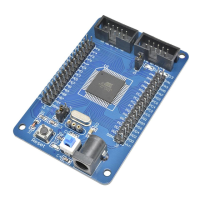72
2467S–AVR–07/09
ATmega128
Table 26 summarizes the function of the overriding signals. The pin and port indexes from Fig-
ure 33 are not shown in the succeeding tables. The overriding signals are generated internally in
the modules having the alternate function.
The following subsections shortly describes the alternate functions for each port, and relates the
overriding signals to the alternate function. Refer to the alternate function description for further
details.
Table 26. Generic Description of Overriding Signals for Alternate Functions.
Signal
Name Full Name Description
PUOE Pull-up
Override Enable
If this signal is set, the pull-up enable is controlled by the
PUOV signal. If this signal is cleared, the pull-up is
enabled when {DDxn, PORTxn, PUD} = 0b010.
PUOV Pull-up
Override Value
If PUOE is set, the pull-up is enabled/disabled when
PUOV is set/cleared, regardless of the setting of the
DDxn, PORTxn, and PUD Register bits.
DDOE Data Direction
Override Enable
If this signal is set, the Output Driver Enable is controlled
by the DDOV signal. If this signal is cleared, the Output
driver is enabled by the DDxn Register bit.
DDOV Data Direction
Override Value
If DDOE is set, the Output Driver is enabled/disabled
when DDOV is set/cleared, regardless of the setting of the
DDxn Register bit.
PVOE Port Value
Override Enable
If this signal is set and the Output Driver is enabled, the
port value is controlled by the PVOV signal. If PVOE is
cleared, and the Output Driver is enabled, the port Value
is controlled by the PORTxn Register bit.
PVOV Port Value
Override Value
If PVOE is set, the port value is set to PVOV, regardless of
the setting of the PORTxn Register bit.
DIEOE Digital Input
Enable Override
Enable
If this bit is set, the Digital Input Enable is controlled by the
DIEOV signal. If this signal is cleared, the Digital Input
Enable is determined by MCU-state (Normal mode, Sleep
modes).
DIEOV Digital Input
Enable Override
Value
If DIEOE is set, the Digital Input is enabled/disabled when
DIEOV is set/cleared, regardless of the MCU state
(Normal mode, Sleep modes).
DI Digital Input This is the Digital Input to alternate functions. In the
figure, the signal is connected to the output of the schmitt
trigger but before the synchronizer. Unless the Digital
Input is used as a clock source, the module with the
alternate function will use its own synchronizer.
AIO Analog
Input/output
This is the Analog Input/output to/from alternate functions.
The signal is connected directly to the pad, and can be
used bi-directionally.

